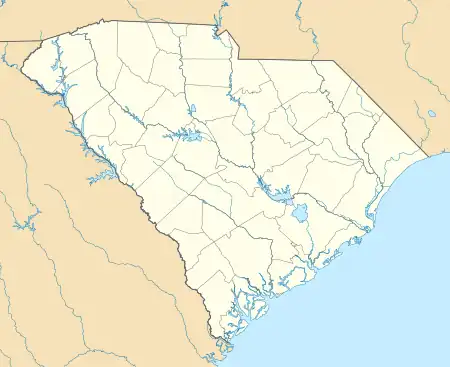Penn Center (Saint Helena Island, South Carolina)
The Penn Center, formerly the Penn School, is an African-American cultural and educational center in the Corners Community, on Saint Helena Island. Founded in 1862 by Quaker and Unitarian missionaries from Pennsylvania, it was the first school founded in the Southern United States specifically for the education of African-Americans. It provided critical educational facilities to Gullah slaves freed after plantation owners fled the island, and continues to fulfill an educational mission. Leigh Richmond Miner photographed students and activities at the school.[3]
Penn School Historic District | |
.jpg.webp) Brick Baptist Church | |
  | |
| Nearest city | St. Helena Island, South Carolina |
|---|---|
| Coordinates | 32.38830°N 80.57530°W |
| Area | 47 acres (19 ha) |
| Built | 1855 |
| NRHP reference No. | 74001824 |
| Significant dates | |
| Added to NRHP | September 9, 1974[1] |
| Designated NHLD | December 2, 1974[2] |
The campus was designated a National Historic Landmark District in 1974.[1] Darrah Hall and Brick Baptist Church on the campus were declared part of Reconstruction Era National Monument in January 2017.[4] In spring of 2019, it became the Reconstruction Era National Historic Park, along with Fort Sumter.
Description and history
The Penn Center is located about one mile south of Frogmore on Dr. Martin Luther King Jr. Boulevard. The 47-acre (19 ha) campus is divided by the road, and includes a number of historic buildings related to the original function as a school, including classrooms, living spaces for students, teachers, and administrators. The dates of construction of many of the buildings is not known, and they are not considered architecturally significant. The oldest building on the campus is the 1855 Brick Church, built by the plantation owners of the island.[5]
At the outbreak of the American Civil War in 1861, Union Army forces quickly captured Saint Helena Island, prompting the local plantation owners to flee. The military administration of the island partitioned the old plantations, giving the land to the former slaves who lived there. The Penn School was established in 1862 by Laura Matilda Towne, an abolitionist missionary from Pittsburgh, Pennsylvania as a school for the freed slaves, which was named for William Penn, Quaker champion for human liberty and founder of Pennsylvania. For many years the work was financed by Philadelphia Quaker abolitionists. Ellen Murray, a Quaker teacher, joined her in the work. Charlotte Forten, born into a wealthy free black family in Philadelphia, joined them as the school's first black teacher. The Brick Church was used as an early meeting, educational, and administrative space, and the school's first dedicated educational building was constructed in 1864, from prefabricated parts shipped from Pennsylvania. The school remained an active educational institution for the island's population until 1948, when the state took over public education on the island. The institution then became the Penn Center, and as continued an educational mission for the island's preschoolers and adults, as well as maintaining a museum, cultural center, and conference meeting space.[2][5] With the creation of the Reconstruction Era National Monument (which in spring 2019 was elevated to National Park status), Brick Baptist Church is protected by a Park Service building easement and Darrah Hall, on the campus of the Penn Center, has been deeded over to the Park Service, as well as the adjacent parking area.
Gallery
 Farmhouse
Farmhouse Building
Building House
House Basket making class
Basket making class Sewing class
Sewing class History class
History class
See also
References
- "National Register Information System". National Register of Historic Places. National Park Service. January 23, 2007.
- "Penn School Historic District". National Historic Landmark summary listing. National Park Service. Archived from the original on June 6, 2011. Retrieved March 10, 2008.
- https://www.worldcat.org/title/photographs-from-the-book-face-of-an-island/oclc/1281684409
- "Presidential Proclamation - Reconstruction Era National Monument (U.S. National Park Service)". www.nps.gov. Retrieved January 17, 2017.
- James Sheire (August 1974). National Register of Historic Places Inventory-Nomination: Penn Center Historic District / Penn School (pdf) (Report). National Park Service. and Accompanying two photos, exterior, from 1965 and 1974 (32 KB)
Further reading
Jordan, Francis Harold (1991). Across the bridge: Penn School and Penn Center (Thesis). Colleges of Education, University of South Carolina. UMI Number: 9214946.
External links
- Penn Center - History and Photos SCIway.net, South Carolina Information Highway
- Penn Center Historic District, Beaufort County (St. Helena Island), at South Carolina Department of Archives and History
- Official website of the Penn Center, St. Helena Island, South Carolina
- Brick Baptist Church web site



